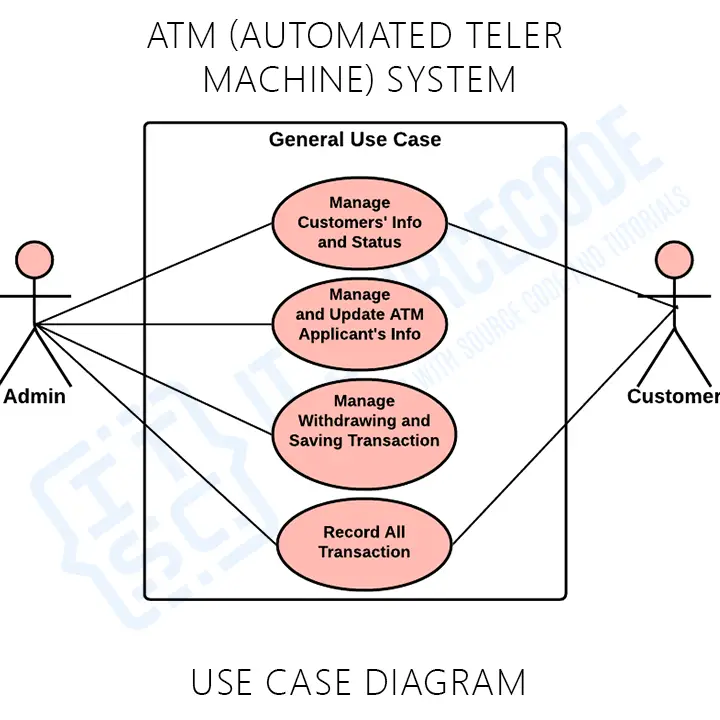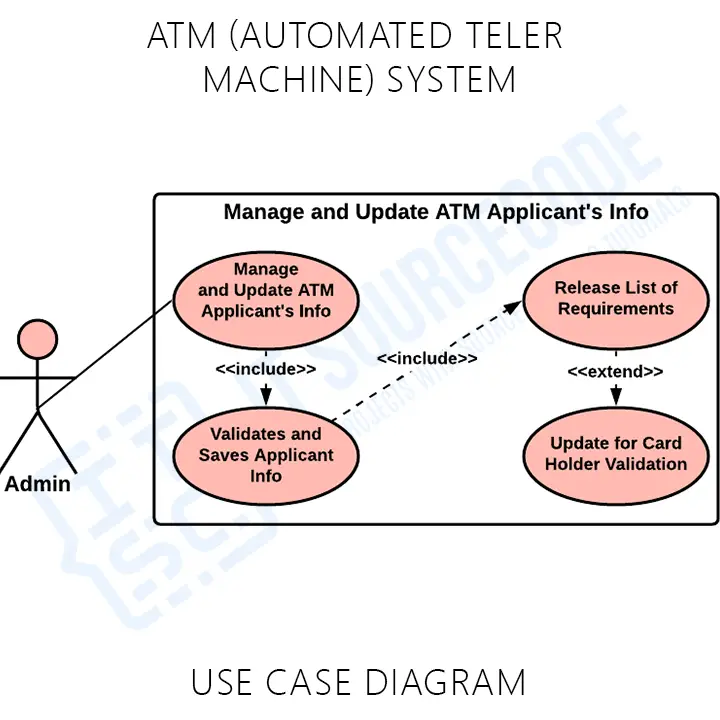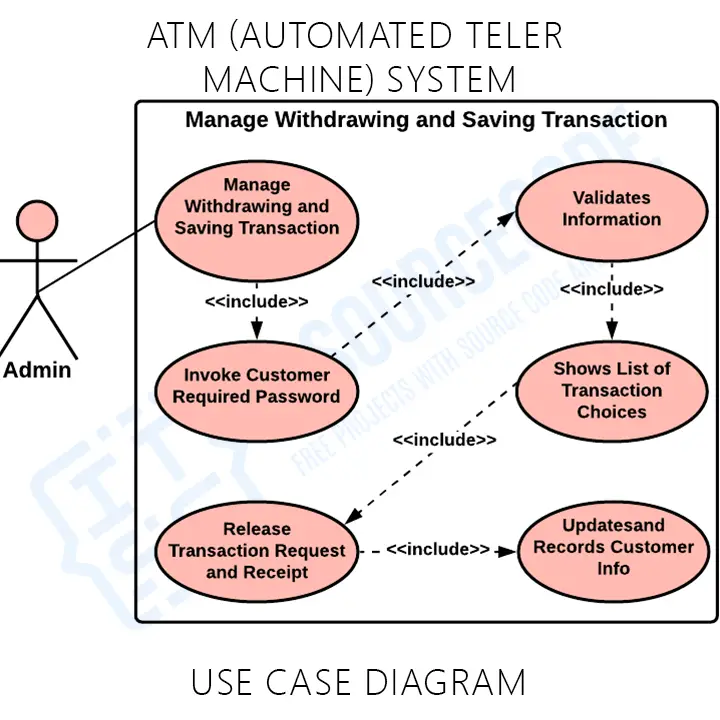The ATM Machine Use Case Diagram is one way that the steps of how an ATM works are shown. It shows how the system is thought to be set up to work. The diagram also has processes (use cases) and users, also called “actors.” It uses defined symbols to show how the whole system works.
Please see our Recommended and Related Articles for additional information and educational opportunities.
- ATM System Project Use Case Diagram using Include and Extend (UML)
- ATM System UML Diagrams
- Activity Diagram for ATM Management System
- ATM Management System Class Diagram
- Component Diagram for ATM System | UML
- ER Diagram for ATM System
- Sequence Diagram For ATM System
- Deployment Diagram for ATM System
Project Overview
| Name: | ATM Machine System Use Case Diagram in UML |
| System Users: | The expected users of the system are the bank admin, employee, and card holders. |
| Tools Used: | Any Diagram tools that provide use case diagram symbols. |
| Designer: | ITSourceCode.com |
What is a Use Case Diagram?
The UML use case shows how the software could be used. It shows how the project works by using use cases, actors, and the relationships between them. Also, the diagram helps you figure out and organize what your project needs. This also makes it easy to see how the user and system work together.
Importance of UML Use Case
One important thing about the UML use case diagram for ATM is that it helps developers and businesses manage their systems. It shows the steps from the users’ point of view.
The diagram also works as a system analysis to find, clarify, and organize the project’s needs. This diagram works best with other ATM UML diagrams. Activity, class, sequence, deployment, and component diagrams are some of the other kinds of UML diagrams.
ATM Machine System Use Case Diagram
The use case has two main illustrations that describe the system’s general and specific processes using include and extend.
ATM System General Use Case Diagram
The general use case diagram for ATM machines shows the main functions of the system. It is based on the transactions done during ATM management.

The general use case is the most common application of a use case diagram. The use case diagrams depict the system’s main components as well as the flow of information between them.
Use Case Diagram for ATM System using Include and Extend
The use case diagram using include and extend is used to elaborate the proceeding diagrams.
The label include indicates that the sub-processes of the main processes must be included to complete the task, extend is otherwise.
Manage Customers’ Information and Status Use Case Diagram
This is the process where the admin (bank teller) monitors and manages ATM card basic information.

Manage ATM Applicants’ Information Use Case Diagram
This process is where the user encodes and validates the cardholder applicants. The admin can also update the applicants’ financial transactions as soon as they passed the requirements.

Manage Withdrawing and Saving Transaction
This is the process where the bank/system admin processes their customer’s info to let them avail the bank and ATM services.

You can add more to this illustration and it is up to you how will you create your diagram. But make sure to have precise information and consider the included use cases.
Use Case Diagram for ATM Machine System Pdf
How to draw a Use Case Diagram?
Time needed: 2 minutes
Here’s the complete guide on how to draw a use case diagram for ATM system.
- Step 1: Familiarize Use Case Diagram Symbols
For beginners, you need to familiarize first with use case symbols to be used.
- Step 2: Determine the system processes
The next step is to determine the system’s processes. They will be the use cases of your project.
You may ask the users about the typical activities done in the ATM machine. - Step 3: Analyze the use cases included
The gathered information from the users needs to be evaluated to know the general use cases.
From the general use cases, you will see the sub-cases that are included. But, only include the useful processes related to the ATM system. - Step 4: Plot the Use Case Diagram
To plot the diagram you will need the users, use cases, container (scope), and their indicators (association). You will base the flow of use cases on the evaluated information from the users.
Your first move is to place the users involved.
Next, put the container in the plotted diagram to separate the objects (users and system) scope.
Then place the use cases of the ATM system.
Finally, you need to map out the association of the use cases to show the interactions between the user/s and the system.
Conclusion
The system development process is shown by the UML use case diagram. It helps developers figure out what kinds of inputs the project could get and what it should do with them. Also, the diagram can be used to model how the software’s use cases work (processes). It shows how one process leads to the next in the system.
Inquiries
If you have concerns about the Use Case Diagram for ATM System, just leave us your comments below.

